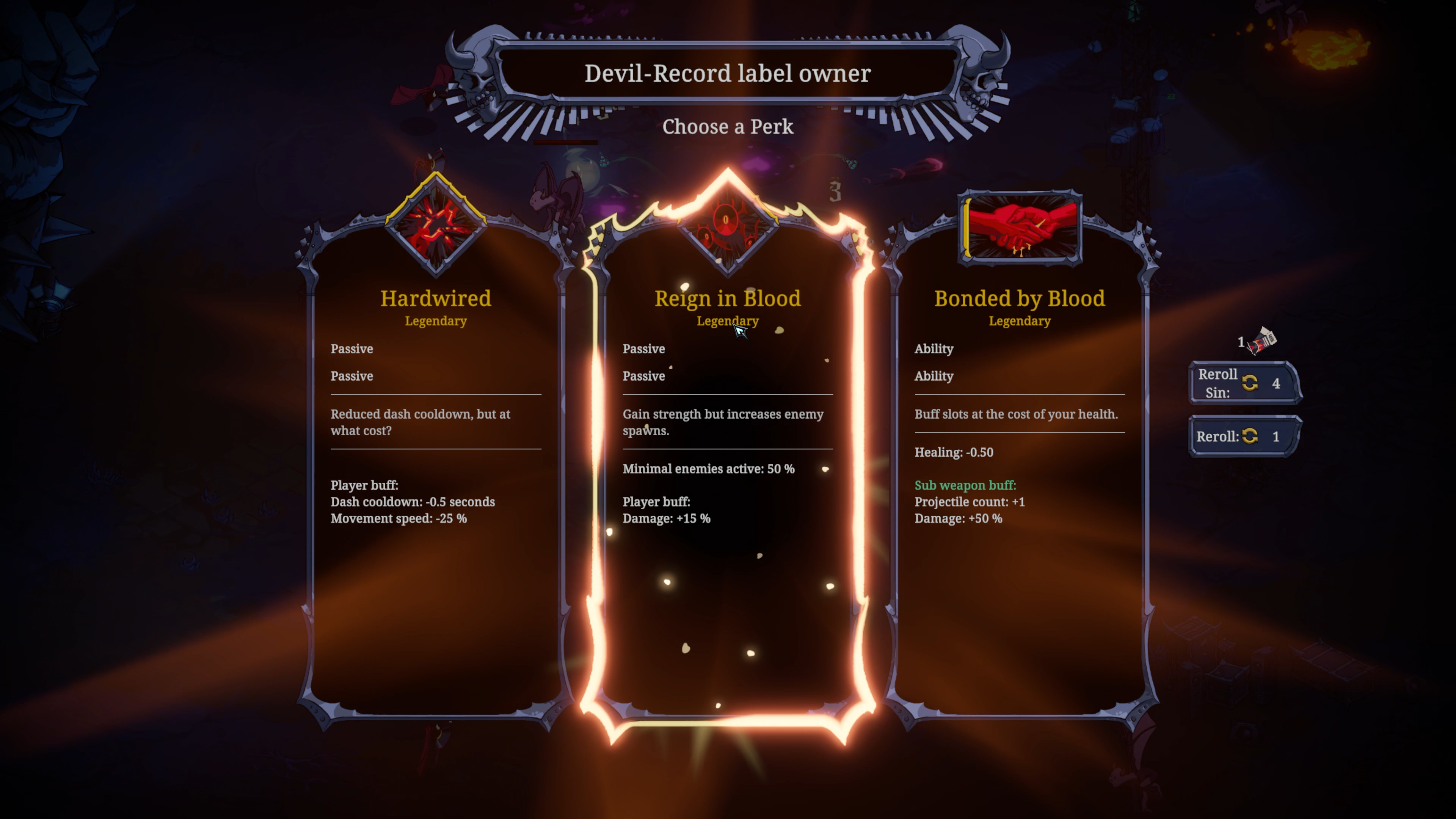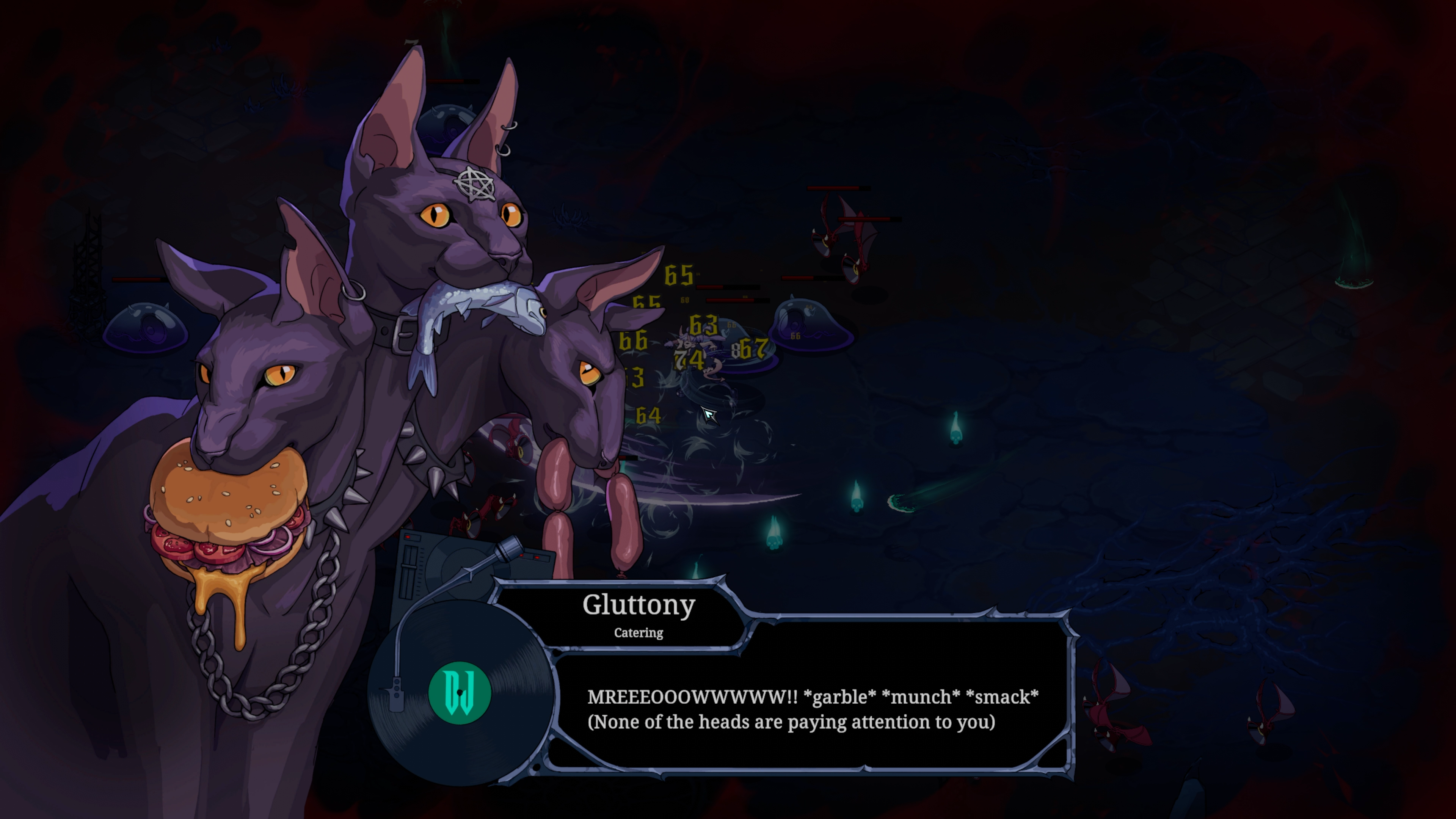
Devil Jam throws you onstage in a fever dream of metal and mayhem: a survivor‑style roguelite that recasts Hell as a blistering concert arena where combat is a nonstop jam. You’re a rockstar bound by a cursed contract, ripped from life and forced to perform for the damned; your possessed instruments auto‑attack on the beat, enemies surge in rhythm, and success comes from arranging your loadout and timing your moves as much as from quick reflexes.
Core concept and tone
• Theatrical, high‑concept hook: Make a Faustian deal, shred through waves of demonic fans and rival acts, and climb the infernal bill to face Death; the premise is instant, cinematic, and easy to sell.
• Spectacle with personality: Bold hand‑drawn art, fluid animations, and a soundtrack that pounds on cue give each run an identity; voice work for the Seven Deadly Sins turns the hub into a memorable, characterful backstage rather than a dry upgrade menu.

What you do (Gameplay loop)
• Beat‑driven auto‑attacks: Your instruments fire on the soundtrack’s pulse, shifting the player’s role from frantic aiming to tactical movement and positioning; timing your dodges and beamlines around the beat makes collisions feel musical and strategic rather than chaotic.
• Run‑based progression and hub loop: Each run escalates with mid‑run levelups that offer new weapons, abilities, or passives, while the hub between runs houses permanent upgrades, vendor choices, and Devil‑issued quests; this loop keeps runs focused and gives each attempt clear short‑ and long‑term goals.
• 12‑slot grid as the strategic core: The 4x3 inventory grid is the game’s signature puzzle; placement and adjacency matter. Abilities form spatial patterns, weapons occupy tiles, and neighboring synergies amplify effects, so build design becomes spatial problem‑solving as much as item selection. The thrill comes from arranging tiles to unlock emergent combos and discovering how patterns change with tempo and enemy density.
• Movement and placement interplay: Because attacks auto‑trigger, player agency shifts to where you stand and how you move: kite to shape enemy waves into your rhythm, use terrain to funnel foes into favored firing arcs, and reposition to let your grid layout do the heavy lifting.
• Risk versus rearrangement tension: The inability to freely reorganize mid‑run amplifies stakes: early placement choices can define a run’s trajectory, creating satisfying “aha” moments when a layout clicks; and frustrating dead‑ends when RNG or placement limits block synergy, highlighting an area ripe for future QoL tweaks.

Progression, hub, and meta systems
• Backstage hub as a living upgrade loop: The hub functions as more than a menu; it’s a theatrical base where Devil’s quests, Poppy’s wares, and Lars’s trades give runs narrative texture and tangible growth. NPC banter and voice work make unlocks feel earned, while persistent upgrades and character unlocks create a steady sense of advancement between jams.
• Rhythmic run structure with clear escalation: Runs are paced around predictable beats: early waves build into mini‑boss confrontations at set marks, and surviving the full gauntlet summons Death as a climactic test. That fixed escalation gives each session clear milestones to chase and a satisfying arc from warmup to crescendo.
• Fast acceleration, pacing concerns: The meta systems let progression snowball; quests, repeatable unlocks, and purchasable upgrades can push players into high power tiers quickly. That early potency is rewarding, but it can flatten late‑run tension; a few balance adjustments or gating options would help preserve challenge and extend longevity.

Visual and audio identity
• Striking hand‑drawn hellscapes: Bold, illustrated environments and fluid character animations give the game a pulpy, album‑cover aesthetic that sells the metal fantasy instantly. Visual clarity and confident silhouettes keep action readable while letting the art amplify theatricality.
• Soundtrack as gameplay engine: Riffs, percussion, and tempo changes do more than set mood; they drive attack cadence and escalate tension. The score makes each run feel like a performance, turning dodges and kills into rhythmic payoff.
• Variety to sustain marathons: The music is memorable and powerful, but adding more tracks and tempo shifts would prevent fatigue during long sessions and better support different combat rhythms.
• Voice work that animates the hub: The Seven Deadly Sins are given distinct personalities through energetic performances, which turn the backstage into a characterful space and make NPC interactions feel earned.
• Worldbuilding with room to grow: Presentation gives strong flavor, but deeper narrative hooks and more environmental storytelling would turn stylish touches into a richer, more immersive world.
Strengths
• Rhythm‑first combat that hooks: The beat doesn’t just flavor combat; it structures it. Auto‑attacks tied to the soundtrack make engagements feel musical and kinetic, turning dodges and positioning into satisfying, repeatable loops that stick with you after each run.
• Spatial strategy from the 12‑slot grid: The inventory is a genuine tactical puzzle; where you place weapons and pattern‑based abilities reshapes cooldown rhythms and synergies. Successful runs reward planning, experimentation, and the delight of discovering combos that feel both clever and powerful.
• Cohesive, confident presentation: Hand‑drawn visuals, fluid animation, and a pounding soundtrack work as a single identity package. The art and audio don’t just look and sound good; they clarify action, sell the theme, and give each run a cinematic punch.
• High‑impact boss design: Boss fights break the routine with multi‑stage patterns and higher mechanical demand, creating dramatic peaks in the run loop and giving players memorable, skill‑intensive tests that reward mastery.

Weaknesses and areas for improvement
• Repetition appears early: Arena layouts, enemy types, and the current soundtrack loop become predictable after a few hours; adding more environment archetypes, enemy behaviors, and musical themes will keep runs feeling fresh and surprising.
• Grid design hampered by RNG and rigidity: The 12‑slot system is clever, but random offerings and the inability to rearrange tiles mid‑run can lock players into suboptimal builds. Allowing limited in‑run rearrangement, more deliberate placement tools, or smarter reroll options would increase player agency and strategic depth.
• Progression spikes undermine later tension: Quests, unlocks, and purchasable upgrades can accelerate power growth too quickly, flattening the late‑run challenge. Tighter gating, diminishing returns on certain upgrades, or adjustable pacing options would preserve the feeling of escalating risk.
• Narrative depth feels thin: The Faustian premise and colorful hub cast promise richer storytelling, but worldbuilding currently leans on surface flavor. Deeper character arcs, environmental storytelling, and more consequential mid‑run narrative beats would satisfy players who want lore alongside gameplay.
• Content breadth and balance need expansion: More maps, enemy variants, playable characters, and soundtrack variety will boost longevity. Alongside new content, focused balance passes to rebalance early power curves and enemy encounter design will improve replayability and long‑term engagement.

Accessibility and settings
• Robust baseline settings: The game offers fully remappable controls, an auto‑aim toggle, multiple language options, and granular audio and graphics sliders to fit different hardware and comfort needs.
• Helpful gameplay toggles: Options such as auto‑aim and a screen‑shake intensity slider let players tailor core feel and feedback, while input remapping supports controllers and keyboard/mouse setups equally.
• Where it could improve: More guided onboarding for the 12‑slot grid, visual tutorials that show pattern placement and adjacency effects, and an option to preview or temporarily reorganize tiles mid‑run would reduce friction for new players.
• Suggested assist features: Addable assists like a simplified grid mode, adjustable enemy density, or an “explain build” overlay would make the systems more approachable without removing challenge for core players.
• Overall: The settings cover many essentials, but clearer teaching tools and a few optional assist modes would significantly broaden accessibility and help more players enjoy the game’s strategic core.
Who should play it
• Fans of Vampire Survivors, auto‑battling survival games, or rhythm‑adjacent action who appreciate quick, stylized runs and grid‑based theorycrafting.
• Players who value presentation; strong art direction, voice acting, and a killer soundtrack; over deep narrative.
• Those who enjoy experimenting with builds and layouts and don’t mind some RNG shaping each run.

Final Verdict
Devil Jam nails a charismatic, high‑decibel identity: a confident mashup of heavy‑metal spectacle and survivors‑style run loops. Its core hooks, beat‑synced auto‑attacks and a placement‑first 12‑slot grid, reward experimentation and make each run feel like a performance shaped by design choices as much as reflexes. The presentation sells the fantasy: bold hand‑drawn visuals, punchy animation, and a soundtrack that actually drives gameplay. Right now the best experiences come in short, electrifying bursts; the game is inventive and consistently fun, but repetition, rapid power creep, and limitations around mid‑run grid management keep it from reaching its full potential. With broader content (more maps, tracks, enemies), tighter pacing and balance, and a few quality‑of‑life fixes around the grid and progression, Devil Jam could move from a stylish foundation to a genre standout; as it stands, it’s a must‑try for fans of rhythm‑driven chaos and build‑crafting, and a promising project to watch as it evolves.
Watch and Wishlist
• Why wishlist: Stay alerted to demo updates, post‑launch patches, and new content drops that expand maps, tracks, and enemy variety.
• Support a bold, high‑concept indie that pairs a unique rhythm hook with strategic grid play.
• Replay the demo across builds to see how balance and QoL fixes reshape the mid‑run grid experience.
• When to jump in: Try the demo or pick it up at launch if you want to experience the core beat‑driven loop and grid strategy now.
• Consider buying after a major content update (new tracks, maps, or QoL grid changes) if you want a fuller, less repetitive experience.
• How to keep up: Wishlist on your platform and follow the developer for patch notes, roadmap posts, and community streams.
• Watch developer streams and community playtests for previews of balance changes and new content.
• Quick take: Wishlist to track progress; play the demo if you love rhythm and buildcraft now, but wait for bigger content and balance tuning if you want a deeper, longer campaign.
Key Takeaways
• Beat‑first combat is the core hook: auto‑attacks tied to the soundtrack make positioning and timing feel musical and strategic.
• The 12‑slot grid adds real spatial strategy: placement, adjacency, and pattern abilities reward experimention and creative builds.
• Presentation punches above its weight: hand‑drawn visuals, tight animation, voice work, and a killer metal score sell the fantasy.
• Best in short bursts: runs are energizing and addictive, but repetition and limited soundtrack/arena variety show after extended play.
• Progression pacing needs tuning: quests and unlocks can accelerate power too quickly, reducing late‑run tension for some players.
• Grid ergonomics could improve: RNG and lack of mid‑run reorganization can lock players into suboptimal builds and reduce agency.
• Great for rhythm and theorycraft fans: wishlist and demo for now; wait for broader content and balance updates if you want deeper longevity.
Game Information:
Developer & Publisher: Rogueside
Platforms: PC (reviewed)
Release Date: November 3, 2025
Score: 7.5 / 10
Devil Jam is a compelling, stylish foundation with a standout core loop that’s best experienced in short bursts today. With expanded content, tighter balance, and a few quality‑of‑life changes around the grid and progression, it has clear potential to climb higher; it’s worth bookmarking or wishlisting for future updates.